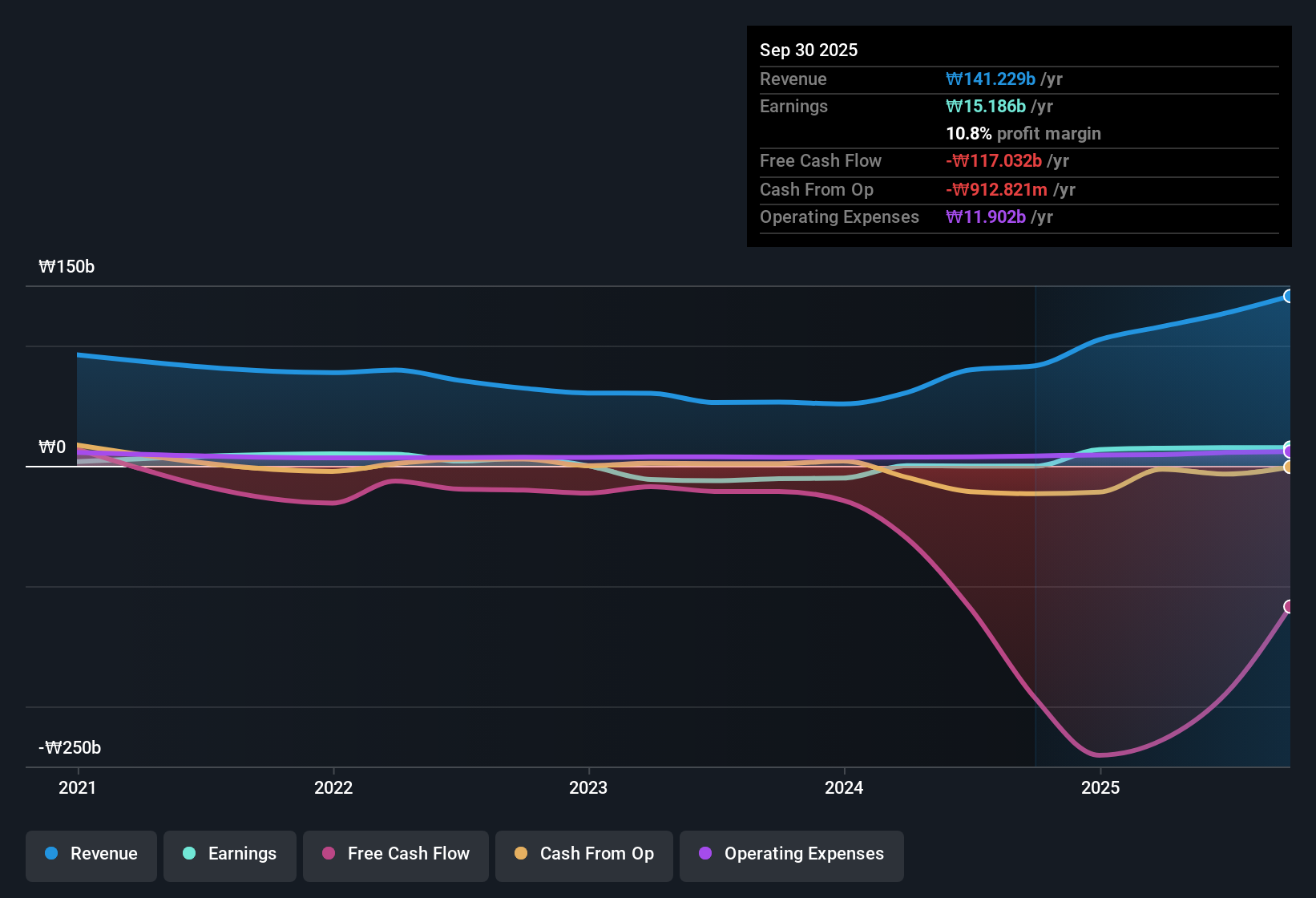- South Korea
- /
- Auto Components
- /
- KOSDAQ:A101360
Eco&Dream's (KOSDAQ:101360) Performance Raises Some Questions
Even though Eco&Dream Co., Ltd. (KOSDAQ:101360) posted strong earnings recently, the stock hasn't reacted in a large way. We think that investors might be worried about the foundations the earnings are built on.

A Closer Look At Eco&Dream's Earnings
One key financial ratio used to measure how well a company converts its profit to free cash flow (FCF) is the accrual ratio. The accrual ratio subtracts the FCF from the profit for a given period, and divides the result by the average operating assets of the company over that time. The ratio shows us how much a company's profit exceeds its FCF.
As a result, a negative accrual ratio is a positive for the company, and a positive accrual ratio is a negative. That is not intended to imply we should worry about a positive accrual ratio, but it's worth noting where the accrual ratio is rather high. Notably, there is some academic evidence that suggests that a high accrual ratio is a bad sign for near-term profits, generally speaking.
For the year to September 2025, Eco&Dream had an accrual ratio of 0.37. Statistically speaking, that's a real negative for future earnings. And indeed, during the period the company didn't produce any free cash flow whatsoever. Over the last year it actually had negative free cash flow of ₩117b, in contrast to the aforementioned profit of ₩15.2b. We also note that Eco&Dream's free cash flow was actually negative last year as well, so we could understand if shareholders were bothered by its outflow of ₩117b. However, we can see that a recent tax benefit, along with unusual items, have impacted its statutory profit, and therefore its accrual ratio.
See our latest analysis for Eco&Dream
Note: we always recommend investors check balance sheet strength. Click here to be taken to our balance sheet analysis of Eco&Dream.
How Do Unusual Items Influence Profit?
The fact that the company had unusual items boosting profit by ₩194m, in the last year, probably goes some way to explain why its accrual ratio was so weak. We can't deny that higher profits generally leave us optimistic, but we'd prefer it if the profit were to be sustainable. When we crunched the numbers on thousands of publicly listed companies, we found that a boost from unusual items in a given year is often not repeated the next year. And that's as you'd expect, given these boosts are described as 'unusual'. If Eco&Dream doesn't see that contribution repeat, then all else being equal we'd expect its profit to drop over the current year.
An Unusual Tax Situation
Moving on from the accrual ratio, we note that Eco&Dream profited from a tax benefit which contributed ₩12b to profit. This is meaningful because companies usually pay tax rather than receive tax benefits. The receipt of a tax benefit is obviously a good thing, on its own. And since it previously lost money, it may well simply indicate the realisation of past tax losses. However, our data indicates that tax benefits can temporarily boost statutory profit in the year it is booked, but subsequently profit may fall back. In the likely event the tax benefit is not repeated, we'd expect to see its statutory profit levels drop, at least in the absence of strong growth. While we think it's good that the company has booked a tax benefit, it does mean that there's every chance the statutory profit will come in a lot higher than it would be if the income was adjusted for one-off factors.
Our Take On Eco&Dream's Profit Performance
In conclusion, Eco&Dream's weak accrual ratio suggests its statutory earnings have been inflated by the non-cash tax benefit and the boost it received from unusual items. For all the reasons mentioned above, we think that, at a glance, Eco&Dream's statutory profits could be considered to be low quality, because they are likely to give investors an overly positive impression of the company. If you'd like to know more about Eco&Dream as a business, it's important to be aware of any risks it's facing. To help with this, we've discovered 3 warning signs (2 don't sit too well with us!) that you ought to be aware of before buying any shares in Eco&Dream.
Our examination of Eco&Dream has focussed on certain factors that can make its earnings look better than they are. And, on that basis, we are somewhat skeptical. But there is always more to discover if you are capable of focussing your mind on minutiae. For example, many people consider a high return on equity as an indication of favorable business economics, while others like to 'follow the money' and search out stocks that insiders are buying. So you may wish to see this free collection of companies boasting high return on equity, or this list of stocks with high insider ownership.
Valuation is complex, but we're here to simplify it.
Discover if Eco&Dream might be undervalued or overvalued with our detailed analysis, featuring fair value estimates, potential risks, dividends, insider trades, and its financial condition.
Access Free AnalysisHave feedback on this article? Concerned about the content? Get in touch with us directly. Alternatively, email editorial-team (at) simplywallst.com.
This article by Simply Wall St is general in nature. We provide commentary based on historical data and analyst forecasts only using an unbiased methodology and our articles are not intended to be financial advice. It does not constitute a recommendation to buy or sell any stock, and does not take account of your objectives, or your financial situation. We aim to bring you long-term focused analysis driven by fundamental data. Note that our analysis may not factor in the latest price-sensitive company announcements or qualitative material. Simply Wall St has no position in any stocks mentioned.
About KOSDAQ:A101360
Low risk with questionable track record.
Market Insights
Community Narratives



